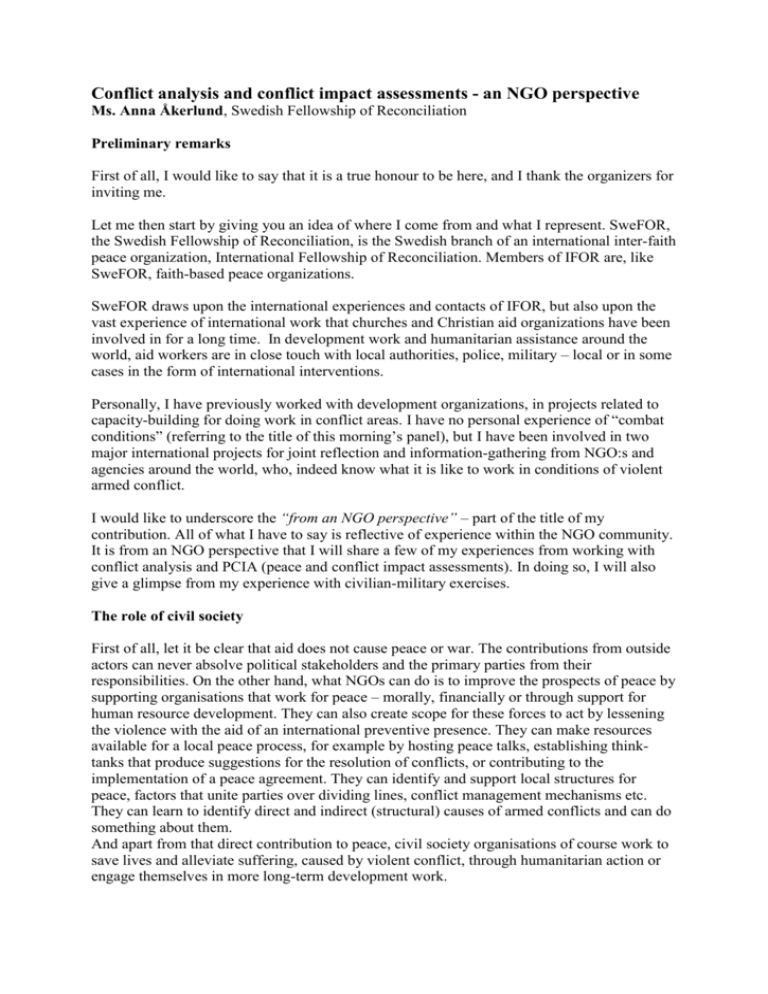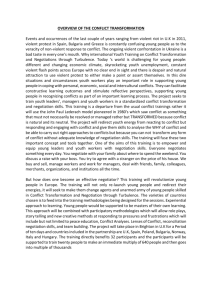Conflict analysis and conflict impact assessments
advertisement

Conflict analysis and conflict impact assessments - an NGO perspective Ms. Anna Åkerlund, Swedish Fellowship of Reconciliation Preliminary remarks First of all, I would like to say that it is a true honour to be here, and I thank the organizers for inviting me. Let me then start by giving you an idea of where I come from and what I represent. SweFOR, the Swedish Fellowship of Reconciliation, is the Swedish branch of an international inter-faith peace organization, International Fellowship of Reconciliation. Members of IFOR are, like SweFOR, faith-based peace organizations. SweFOR draws upon the international experiences and contacts of IFOR, but also upon the vast experience of international work that churches and Christian aid organizations have been involved in for a long time. In development work and humanitarian assistance around the world, aid workers are in close touch with local authorities, police, military – local or in some cases in the form of international interventions. Personally, I have previously worked with development organizations, in projects related to capacity-building for doing work in conflict areas. I have no personal experience of “combat conditions” (referring to the title of this morning’s panel), but I have been involved in two major international projects for joint reflection and information-gathering from NGO:s and agencies around the world, who, indeed know what it is like to work in conditions of violent armed conflict. I would like to underscore the “from an NGO perspective” – part of the title of my contribution. All of what I have to say is reflective of experience within the NGO community. It is from an NGO perspective that I will share a few of my experiences from working with conflict analysis and PCIA (peace and conflict impact assessments). In doing so, I will also give a glimpse from my experience with civilian-military exercises. The role of civil society First of all, let it be clear that aid does not cause peace or war. The contributions from outside actors can never absolve political stakeholders and the primary parties from their responsibilities. On the other hand, what NGOs can do is to improve the prospects of peace by supporting organisations that work for peace – morally, financially or through support for human resource development. They can also create scope for these forces to act by lessening the violence with the aid of an international preventive presence. They can make resources available for a local peace process, for example by hosting peace talks, establishing thinktanks that produce suggestions for the resolution of conflicts, or contributing to the implementation of a peace agreement. They can identify and support local structures for peace, factors that unite parties over dividing lines, conflict management mechanisms etc. They can learn to identify direct and indirect (structural) causes of armed conflicts and can do something about them. And apart from that direct contribution to peace, civil society organisations of course work to save lives and alleviate suffering, caused by violent conflict, through humanitarian action or engage themselves in more long-term development work. Conflict analysis and PCIA and intelligence gathering A Peace and Conflict Impact Assessment is a systematic way to analyze the impact of your programme or project on a given conflict setting. I have become aquainted with a framework to assess the impact of aid on conflict, that has been developed in the so called Local Capacities for Peace Project (LCPP) of the Collaborative for Development Action (often referred to as the “Do No Harm” framework). Along with conflict analyses (trying to reach a deeper understanding of the conflict as such), we do these analyses because we want to increase the effectiveness of our work and because we are accountable to the people, the most concerned. Whether we are working on conflict or simply in a conflict environment, we are going to have some kind of influence on the context of conflict. We want to make sure that we do not lessen, but rather that we increase, the likelihood for peace through our presence. Is aid being given in ways that legitimize war-related individuals (giving them more international attention, power, prestige…)? Does the aid agency rely on arms to protect its goods and/ or workers? Does the aid agency’s publicity and/or fund-raising approach demonize one side of the war? Is aid provided in ways that benefit one group over others? These, and more questions like these, need to be addressed. It is always the details that count. (As in one example when an organization started an agricultural support programme and decided that in order to get the best people to run it would be to recruit staff at the agricultural college. Only later - a couple of years into the programme - did they realize that that decision resulted in a pretty much mono-ethnic programme in an area where there was a violent conflict that coincided with ethnic dividing lines – and where land tenure and therefore agriculture was a very hot issue. By then, they were already in trouble with their programme). By being and working in a conflict you influence the conflict – often in ways that you will have difficulties to foresee unless you use some kind of tool for systematic analysis of your impact on conflict before you go there. And this is in pretty small-scale projects that do not aim to influence conflict. How much more is it not then possible to influence the conflict context – for better or for worse – when actors actually set out to influence the conflict! PCIA helps you to trace those impacts. (N.B. It is not prescriptive.) This is not the time to explain the tool. Instead I shall focus on a few questions, as they relate to information gathering. Who does the information gathering? In PCIA you look at your own project, what you are going to do, but also your own organisation’s mandate and funding. Are you a third party? But what if you are linked to a secondary party? This is very much debated right now, when many people witness to an increasingly dangerous environment for humanitarian workers, due to a blurring of the line between humanitarian and military objectives. From whom does the information originate? Credibility. Double-check with various sources. How is information gathered? How is it accepted or verified? With whom? It is highly recommended that you do the analysis together with your partner organization and representatives of your target group. As close as possible to the target group. What information? It is impossible to know everything. You have to make priorities: what is the most vital information? Also: how do I learn to ask the right questions? Unless you ask the question, you are unlikely to get the answer – or recognize it as an answer. When? Monitoring. Not once and for all, but continuous. Why? It has to do with mandate. What are your indicators of success? (In a workshop I once co-facilitated in Melbourne, a couple of Australian military men taught me the useful word “mission creep”: when your mission is diverted into something else, almost without you knowing it). Do you only collect information about the context or do you also gather indicators of your own performance, information by which you hold yourself accountable? Development and humanitarian organizations have, of course, always done risk analyses before entering a areas of crisis or conflict. The question in those instances is: how can the conflict effect my project? What are the risks? With PCIA that question is reversed: how will my project, my programme, my presence influence the conflict? I am drawing towards the end of my presentation, but before I close, I would like to share an anecdote with you from my visit to the joint civilian-military exercise, Viking 01. SweFOR has taken part in civilian-military exercises since Nordic Peace 1998 (Viking 99, Nordic Peace 02, Viking 01 and Viking 03). My visit in 01 was my first encounter with these. The fictitious conflict (in “Bogaland”) was described to me, and it was apparent that it was a very violent conflict. Yet, I also learnt that there were no casualties since the beginning of the international military intervention there. Finding this a little bit unrealistic, I asked questions about it. Only after several minutes of discussion (and, I must admit, confusion) I realized that “casualties “ in this case meant “military casualties”! Apparently civilian casualties were not considered relevant information in that setting. And yet, the UN-mandated mission was in principle there to protect civilians, or was it not? (According to the scenario, this was a PSO during time of preparation for elections and disarmament). The answer I got, was that this had something to do with the distinction between military and civilian roles. While I totally respect the strict upholding of that distinction – and, indeed, I think it is really important – my question is: what exactly is then the relation to the political goal, the goal that after all should be overriding? And that question remains with me. I found that whole conversation a sort of a culture shock for me and a great challenge and maybe an eye-opener too. For me, the experience was a major revelation about what information was deemed relevant, and what part of reality the exercise (and possibly operations of that sort) choose to relate to. And - turning now to PCIA and its annoying but important questions about unintended negative impacts - if the presence actually decreases the security of civilians, would you even know it? The kind of questions, that you ask yourself, shape the information, that you choose to gather – and this enterprise is not neutral. It tells us something about yourself, I believe. Therefore, I do appreciate the opportunity to come here and talk about intelligence gathering and sharing, realizing that intelligence mean very different things in our different settings. The following scibbled notes is what I noted for use in the open discussion, that followed upon our interventions: What we should talk about is intelligence gathering with the objective to avoid ever having to deal with “rendering assistance in combat situations” – simply because there will be no combat… In other words: focus on prevention. SweFOR goals for participating in joint civilian-military exercise: 1. To highlight the peace building capacity of the civil society, before and during violent conflicts and in post-war situations 2. To contribute to the perspective that the local civil society is more than a victim in violent conflicts and can also act as an agent of change in peacebuilding 3. To enhance knowledge of the participants as to the role of religion and the religious community in conflicts with violent components, with special emphasis on the peace building capacity of religious communities, representing different parties 4. To highlight the concept of nonviolence as an instrument of analysis and as an alternative way of acting in violent conflicts 5. To contribute to the discussion on preventive action in relationship to Peace Support Operations and to distinguish between curative and preventive measures in this respect 6. To enhance the capacity of civil organisations to participate in peace support operations, based on the concept of nonviolence and a culture of peace 7. To disseminate the experiences made through the various civil-military exercises that SweFOR has participated in, to other civilian organisations, on national as well as international level







